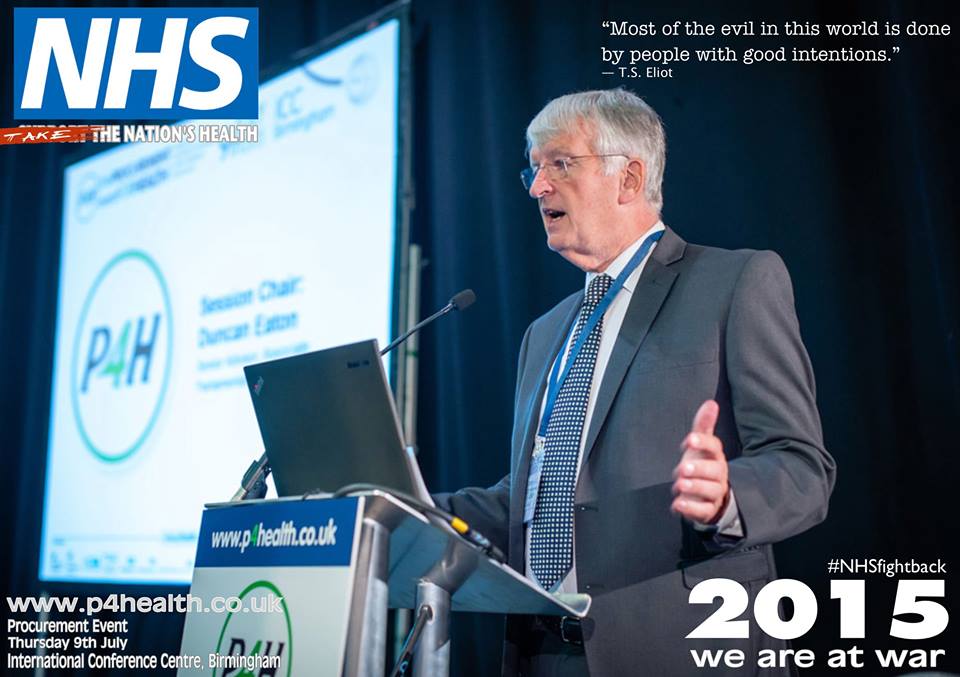The contract for Calderdale Royal Hospital services, which should have started on 1 April 2015, is still not signed and on 24th July both parties entered arbitration with the Centre for Effective Dispute Resolution (CEDAR) as mediator. The outcome is not yet public knowledge – but contract negotiations were still continuing on 4th August.
Problems with the contract from the Calderdale Clinical Commissioning Group’s (CCG’s) point of view were discussed at the June 11th Calderdale CCG Governing Body Meeting, while the hospital Trust’s 28th July Board meeting papers show some of their side of the conflict.
The Trust are holding out for a Payments by Results contract, which Dr Matt Walsh told the CCG Governing Body “is not the CCG’s preference”. Until now, the contract between the CCG and Calderdale and Huddersfield NHS Foundation Trust (CHFT) has been a block activity contract, where the CCG pays for a set amount of clinical activity.
The barcoded patient
Payment by Results (PbR) was introduced in the NHS by the New Labour government in 2003. A 2009 document says it was a key part of New Labour’s reform of the NHS.
PbR makes the money follow the patient. It is a key precursor to the introduction of a private health insurance system.
CCG Finance Officer Julie Lawreniuk told the Governing Body meeting:
“A PbR contract is like a patient having barcode across their head – payment is for each treatment as it happens.”
At the Procurement for Health Trade Fair in Birmingham on July 9th, a bloke from the procurement and commercial division of the Ministry of Health extolled just such a barcoding system, that has been developed by a Derbyshire hospital. He sees this as useful for the new Adjusted Treatment Index, which all hospitals will have to follow in order to increase their efficiency by ticking a load of cost measurements for everything and not diverging from the average. As if. The whole point of an average is some are above and some below.
This short video explains what’s wrong with the concept of PbR, which is paid on the basis of average prices, and how it plays to the interests of private health companies and hospitals with no PFI debt.
Regardless, Lord Carter’s June 2015 Review of Operational Productivity in NHS Providers sees the Adjusted Treatment Index to measure pay and non pay costs as key to creating a “modular hospital” where everything is standardised. The Adjusted Treatment Index is also supposed to be a “very exciting contribution to clinical teams taking better ownership to deliver better value and better care.” I guess Monitor is pushing this hard and this may explain the hospital Trust’s insistence on a PbR contract. But given Calderdale Royal Hospital’s massive PFI debt (the PFI contract swallows 1/10th of Calderdale’s annual NHS budget), it’s hard to see how PbR is going to work in the Trust’s favour, given its costs are likely to be higher than average because of PFI.
Dr Matt Walsh, the CCCG Accountable Officer, formerly the Chief Officer, told the Calderdale CCG meeting:
“The live PbR arrangement is not the CCG’s preference. PbR takes us into mechanistic counting, coding and charging – it will have impact on the way we want to develop services. But this is where Trust have landed in terms of their position. This is where arbitration has come from and there will be more confrontation and discussion.”
Under PbR a national rate, or tariff, is set annually for each type of service. Commissioners are then required to pay for healthcare provided to their patients at this tariff.
With PbR, both hospital providers, and particularly commissioners, face greater financial risk and reduced financial control. Because the money follows the patient, who choses where to have their treatment.
A payment by results contract with the hospital is an obstacle to Care Closer to Home
Dr Caroline Taylor, a GP rep on the Governing Body, asked how payment by results can affect CC2H models of working. She thought it would make it more difficult to pay GPs and other community health services providers for Care Closer to Home services if the CCG was already contracted to Calderdale and Huddersfield NHS Foundation Trust (CHFT) with a PbR contract
The Finance Officer Julie Lawreniuk agreed.
Dr Matt Walsh, the CCG Accountable Officer, said,
“This isn’t going to get in the way of the CCG delivering CC2H. But it makes it more difficult to work in partnership with CHFT.”
Julie Lawreniuk said that the dispute process is set out in the contract and that the CCG would be following this. She said that CHFT had referred the CCG into this dispute resolution process and that it was not an arbitration process.
She said that the Trust is looking for £10m extra across both CCGs. This is about 7 day working- although Ms Lawreniuk said this is included in the tariff (agreed activity contract). Other issues are about 2 site working and about 4 other issues.
Dr Brooks said CHFT contract management will feature more prominently in discussions throughout the year.
Ms Lawreniuk said:
“This has been an extremely challenging contract negotiation round”
Calderdale CCG has a target of £4m “efficiency savings”. The financial plan was for £2m to be cash releasing (ie cutting the cost of services, as distinct from providing more services for the same cost, which does not release cash), but it now looked as if the cash releasing efficiency savings will be £1.5m.
Ms Lawreniuk said the CCG was likely to have a live PbR contract with CHFT – although this was not agreed yet- and this allows cash releasing efficiency savings, which a block contract doesn’t.
Risks of Payment by Results contract
Ms Lawreniuk said that the block contract has allowed risk management at the start of the year. With PbR, there is a risk (for commissioners) that activity increases beyond what’s planned for, and the CCG has to pay within the year.
Ms Lawreniuk said that the Trust is looking for extra payments beyond the agreed activity level. The CCG is resisting this.
Ms Lawreniuk said a key risk was that the contract with CHFT has not yet been signed.
She said that the CCG’s money was getting tighter and that a CHFT “live” PbR contract exposes the CCG to new risks that they haven’t had before. The available pot of money is shrinking.
Dr M Azeb said that a PbR contract carried a risk to the CCG if the hospital “overtraded”, but if Trust didn’t do the full amount of activity CCG could save money.
Ms Lawreniuk said,
“There’s no suggestion activity’s going down.”
She said that there will be more focus on numbers and accounting as result of live PbR contracting and that the CCG want a sustainable Trust.
The contract value from last year would be £244m this year across Greater Huddersfield and Calderdale CCG, but is £248m in fact this year because of demographic growth and non-elective data (a point which I don’t understand).
P. Wagstaff raised the issue of ambiguity of coding. This is about entering the right code for the treatment that has been carried out, in order to trigger the appropriate payment.
JL agreed and said this takes resources, but didn’t say what resources.
Rising acute and emergency hospital admissions as a result of problems with community care
The hospitals Trust’s side of the contract conflict story is in the papers for the 28th July Board meeting. While the Trust’s contract with Calderdale CCG is under dispute, the Trust is operating on the assumption that all clinical activity will be paid under PbR rules.
The CHFT’s Month 3 Financial Narrative, presented to the 28th July 2015 Board Meeting, shows that the hospitals Trust has “overperformed” on clinical income. In other words, it’s brought in more income than expected.
CHFT has had to increase the number of beds and staff to make up for a number of intermediate care nursing beds that have been removed from the Calderdale community system until further notice. This is an ongoing issue.
This is on top of an ongoing shortage of residential care capacity across both Calderdale and Kirklees, which is significantly affecting CHFT and causing a rise in non-elective emergency admissions.
This has added to CHFT’s costs, particularly its pay costs
However, Calderdale CCG has refused to pay invoices to pay £0.42m invoices for additional bed and medical capacity in April.
The hospitals Trust has also exceeded planned non-elective activity at an additional cost of £0.88m, which means it has brought in extra income. In the year to date, non-elective admissions overall are above the plan by 3.2%, with “a continued increase in both emergency long and short stay admissions in month”
Since Calderdale CCG is monitoring whether Phase 1 of the Care Closer to Home programme reduces acute and emergency admissions, and if it doesn’t this may lead the CCG to put CHFT’s community services out to competitive tender; and since the whole point of Care Closer to Home is that it is meant to make it possible to cut acute and emergency hospital services by reducing the need for them, where does this leave the Care Closer to Home programme?
Relatedly, Locala patients’ emergency readmissions within 30 days have increased and are worse than the targets. This is associated with changes to Locala’s care methods and Locala is now reviewing its used of reduced face to face contact with patients. This seems to suggest that the much vaunted increase in the use of digital technology to cut costs of care in the community may not be such a great idea.
However, A&E attendances are below the plan cumulatively by 1.2% (462 attendances).
Planned day case and elective activity is below the year to date plan, cumulatively by 2.1%.


